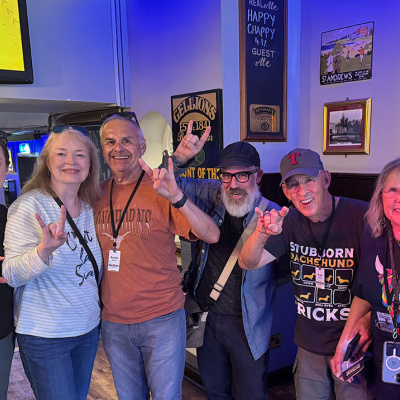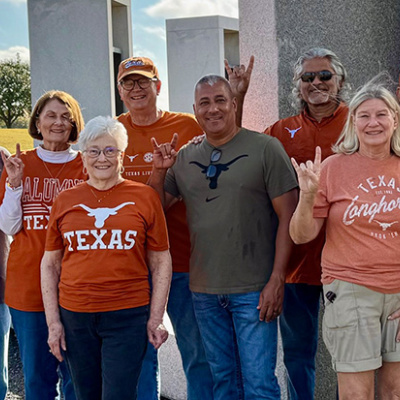Rounding Up the Best for Texas
Outgoing executive director Jim Boon shares what he learned during 16 years managing the Texas Exes: how UT really works, what building relationships is all about, and what role the 40 Acres Scholarship Program can play in UT’s future.

Jim Boon: When I first came on the job I was pretty confident about my ability to manage a business. The thing that I totally underestimated was what it took to manage volunteers. We have been incredibly blessed with volunteers who love the University and want to give back, and I have learned a lot from them.
I can’t say enough about the leadership we have had on our board of directors. Really terrific people. Every Association president has been different, and they have all brought their own strengths to the equation. That combination of skills and strengths combined with what we’ve got here on staff is what has really made the Association prosper. When I talk to my colleagues around the country, they’re struck by how successful we have been here in having our board focus more on strategy and the staff implement it.
One of the reasons we’ve been a successful organization is that we have maintained a good balance between holding on to the past while at the same time responding to a changing environment. Our goal is to communicate with and involve alumni and friends so they feel part of the university community even after they’ve left campus.
Tim Taliaferro: Has it always been a good relationship between the Texas Exes and UT?
JB: The relationship has changed over time, but I can’t imagine it being better than we have right now. A lot depends on the leadership we have on our board of directors and that they’re well respected by the administration. Then it’s highly dependent upon the personal relationship between the executive director and the president of the University.
TT: What have presidents looked to you for?
JB: I hope they have sought my advice and counsel outside the organizational structure of the University. They know there are alumni who are willing to share things with me that they wouldn’t share with the administration directly.
Part of my responsibility is keeping a finger on the pulse of the alumni base, and I need to be able to communicate that candidly. That only happens if there is a comfort level between the two people. Whether it’s a coach’s salary or admissions data or the controversy over renaming a dorm, all of those are in the public eye. Because I interact with a lot of alumni, I have opportunities to hear their unfiltered perspectives.
TT: Have you ever experienced tension between the Exes and UT?
JB: The Alcalde is published by the Association, and the administration does not control it. There have been times we’ve taken an angle on a story that the administration wasn’t happy with. At the end of the day, every president I’ve worked with recognized the value of an objective alumni publication. It enhances our credibility with alumni, and therefore as we accurately report on something going on at the University, it’s got credibility that can actually help the administration.
TT: What are some areas where you think UT could improve?
JB: My personal position may be at odds with the academic community, but I really think the University could become a real leader in academia by trying to look at the enterprise as two separate functions — academic and support — and then run the support operations like a for-profit business.
This is already starting to happen. IT has been reorganized, but departments like human resources, facilities management, public affairs, and accounting need to be looked at through a set of business eyes. One of the things that really jumps out is the way the office of development is organized. We have created a model where deans are expected to spend a majority of their time fundraising.
My perspective is that the University would be a lot better off if it had a more centralized development operation, where there was better coordination in contacting alumni regarding philanthropy. I hear this all the time. Alumni complain about being contacted from six or eight different entities at the University and everyone wants money, so from their perspective it doesn’t look like things are very well coordinated. The decentralized model doesn’t do a very good job of managing major donors or prospects. Far too often the usual suspects are inundated with gift requests.
The theory behind the decentralized model is that you raise more money. I’m not convinced that that’s the case, particularly when you look at the cost of raising money. Every school and college has its own set of development and alumni relations staff, which creates lots of duplicate expense and unnecessary inefficiencies. You talk to alumni from a place like Stanford, they think of giving to Stanford, as opposed to giving to the school of business or education.
TT: Have you talked candidly with the president about that?
JB: Bill Powers was dean of the law school, so he really respects the authority of the deans. I don’t think he was very well served by central development when he was a dean. And so that has a real impact on his perception of the way things ought to be organized.
I’ve learned coming out of the private sector that academia is different. You can’t impose a business mentality on everything at the University. Colleges and universities have endured for centuries for a reason, and it’s the way knowledge is pursued that makes academia different. That is something we need to be careful to preserve.
TT: UT and the Legislature have been at odds in the last few sessions, and this upcoming one looks like it won’t be a love fest either. What has been your experience at the Capitol?
[caption id="attachment_3100" align="alignright" width="400" caption="Photos by Santiago Forero"]

[/caption]
JB: One thing that’s always struck me is that the Legislature seems to bend to the short term and is not willing to make the long-term, difficult choices about investing in education. K-12 and higher education are not expenses — they are investments in the future. In the last few sessions, the funding for higher education has continued to go down as a percentage of the total cost, and all that does is shift the cost to tuition and philanthropy. It’s too bad; it’s short-sighted. The state’s going to wake up one day and have an undereducated work force.
TT: Does the University have an image problem in Texas?
JB: There are some people who think The University of Texas is arrogant or that its alumni are arrogant. Rightly or wrongly, it doesn’t matter; perception is reality. This is an incredible institution and our alumni take great pride in what goes on here and sometimes, unfortunately, I think that does come across as arrogance.
TT: How does the Association interact with the UT System?
JB: Technically, we don’t have any formal relationship with the UT System, although we have worked very closely with it and with the Board of Regents. We’ve always tried to be a resource to the system, whether on a legislative matter or just alumni feedback. Francisco Cigarroa has been an outstanding chancellor, and he is building a lot of bridges. He and his staff have been an absolute delight to work with, and he’s been very open and available to alumni. History will show James Huffines as one of the best chairmen of the board, ever. He worked tirelessly and was a great consensus-builder.
TT: What is the Association’s relationship like with Athletics?
JB: The athletics program at the University of Texas is an integral part of the student and alumni experience. We’ve always channeled a lot of resources into student activities here at the Texas Exes because we know if we enhance their experience, it’s going to lead them to be better alumni.
Right now the Association has the best relationship it’s ever had with Athletics. I attribute a lot of that to [women’s athletics director] Chris Plonsky, who has really reached out to us and vice versa.
TT: How has the relationship between the Association and Athletics changed? What do you remember about how it used to be?
JB: Early on there was a sense of competition — that we were competing for alumni loyalty and dollars. I think that DeLoss Dodds and Chris Plonsky get it and don’t believe that that’s the case. I’m not convinced that the Longhorn Foundation gets it; I still sense some competition, which I think is unwarranted.
TT: How has your impression of students changed?
JB: The student body today is more serious than when I was in school in the ’60s. There are still a lot of opportunities for students to party and have a good time. But I am very impressed with the number of students who are pursuing an education in order to give back to society — who want to go into public service or Teach for America or something like that. The Greek system plays a much less important role in student life than in the past. There is just a different mindset. When I was in school, there seemed to be more, “How do I get my degree, get out, and start earning a living?”
TT: You worked in the insurance business before you took this job. How was the shift to a nonprofit environment? What did you change?
JB: The first thing I had to do was become more patient, and there are some people who still say I haven’t made much progress on that point. The decision-making model in a nonprofit environment is just different than in a profit environment. It takes longer, and there is more consensus-building.
The real key was the transition I had with my predecessor, Roy Vaughan. Roy was a father figure and somebody I have great respect for. He really understood the role of an alumni association and the value of building relationships. Those were frankly foreign concepts to me, and he spent a lot of time trying to make sure that I understood them.
TT: If you were to write job descriptions for your job when you first got here and now that you’re leaving, how are the two different?
JB: It’s important that my successor be very comfortable with technology. That was less important when I was hired. There is going to be more and more emphasis on our ability to communicate and engage with alumni using technology. That’s going to be uncomfortable for some people. We can’t abandon some of the things we’ve done in the past.But we have to be able to shift and communicate more using technology. We need to recognize that not all events are going to happen in Austin, and not all involvement is going to occur just as a result of person to person.
We’re really fortunate in that every May we get 10,000 new prospective members. We know a lot about them and they’re all relatively young. We need to communicate with them the way they want to be communicated with. In today’s world, that is social networking and things I don’t understand and frankly am not very comfortable with.
TT: What are some of the things we can’t abandon as we move forward?
This association is very good at building relationships and keeping an institutional memory. Sometimes, in the hustle and bustle of the world, where everybody is focusing on the ‘what have you done for me lately,’ the University overlooks the value of the relationship building and institutional knowledge that exists around here. We know things under this roof that you just can’t put in a database. And it’s because we have had great employees on the staff, a lot of longevity, and that information gets passed down from staff member to staff member. The University has one of the best alumni associations essentially for free. Other universities spend millions of dollars on alumni relations. Because of our self-governance and our great relationship with the administration, UT gets the benefit of both worlds.
But we’re still here to do everything we can to support The University of Texas. The way we go about doing that may be different than it was 16 years ago, but that’s still the litmus test: is what we’re doing supporting the University?
TT: Speaking of supporting the University, you will be leading the Association’s most ambitious effort ever with the 40 Acres Scholars Program. How did that come about?
JB: One of the responsibilities of the executive director is to have a vision for the Association, and a vision is long term. You need to try to anticipate what might happen and how we can react to it. One of the things that became very apparent to me over the last five years or so is that scholarships is clearly one of the strengths of this association.
We’ve done a very good job at administering scholarships for a long time. And we can do it better than the University can because we’re smaller, more nimble, and able to put a personal touch on it. It was clear to me that scholarships were going to be an increasingly large part of what we do here.
The University was becoming less competitive for the top students because it couldn’t offer good financial packages. The Texas Exes was already doing a good job with need-based scholarships. This year we gave away $2 million to more than 700 students, and most of those were need-based scholarships. But the University needed a nationally recognized merit-based scholarship program, similar to Morehead-Cain at UNC or Jefferson Scholars at UVA, and we were the logical entity to administer that.
Coincidentally, the University was in a capital campaign. We had never had an official role in a capital campaign, and in fact we have never really been a fundraiser. We’d been real good at answering the telephone when someone wanted to create a scholarship.
So a combination of all those things said we’re uniquely positioned to do this for the University. We talked among our leadership, I talked to a lot of alumni about it, and universally people think it’s a good idea.
It has re-energized me. My original thought was that I would retire on Dec. 31 and that would be the end of it. But as I’ve gotten more involved in this 40 Acres Scholars Program, I’m energized. I can be a real asset to the next executive director for the next three years by shouldering this responsibility and letting him or her worry about everything else at the Association.
TT: What do you envision the legacy of the 40 Acres Scholars Program could be?
JB: The goal is that 10 years from now you want some student to say, “I was a 40 Acres Scholar,” and anybody in the country would know that he or she was a top student at The University of Texas. I’m absolutely convinced that this program will develop some incredible leaders for the future of this state and country. We have the opportunity to have a role in the future just by virtue of what we can do with the students who participate in this program.
TT: What are the points of emphasis for the program?
Two big things. One is we want in this first cycle to build a system that can last. The recruitment process, interview process, selection process, first-year retreat. It’s really important we get it right the first year because we’ll be building on that. Two, we need to raise more money for these scholarships. So I hope to spend a lot of time with donors and potential donors.
TT: Are there particular aspects of the program that alumni respond to?
JB: I like to tell people that this isn’t just a scholarship or a check, it’s an experience. It really resonates with folks when we talk about the service-learning project, study abroad, internships, learning lunches with distinguished alumni, personal financial management, leadership training, all those things. It all fits together to create a unique experience for these students that they’re not going to get anywhere else.
TT: What’s been the reaction from faculty and administrators?
JB: President Powers has been very supportive, and I think everybody knows that the University — because of budget reasons — is not automatically giving National Merit scholarships. A lot of these students that get this award are going to be National Merit Scholars, so this can help the reputation of the University.
A number of the deans have really picked up on this as a great way to recruit top students. The star is Dean Tom Gilligan from the McCombs School, who has really embraced this concept. Around half the scholarships we’ve raised so far will be for McCombs students because he has been very good at stimulating his base of supporters to give.
Our goal is for each cohort of scholarship recipients be representative of the whole campus. So in an ideal world you’d have someone from each school or college in every cohort. We want a diversity of interests, majors, hometowns, etc.
TT: When you look back at your time as executive director, what are your highlights?
JB: The highlight has been the people that I’ve worked with: the presidents of our association, the deans, the executive management of the University, and just outstanding alumni. This is a dream job because you get to meet some incredible folks and people who really, really love The University of Texas.
Universities are wonderful, wonderful institutions. For me it’s really been fulfilling to be back on campus and be associated with great professors and great students. I never took for granted the time that I got to spend with those kind of people, particularly students. They give me great hope for the future.





